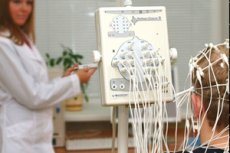
All iLive content is medically reviewed or fact checked to ensure as much factual accuracy as possible.
We have strict sourcing guidelines and only link to reputable media sites, academic research institutions and, whenever possible, medically peer reviewed studies. Note that the numbers in parentheses ([1], [2], etc.) are clickable links to these studies.
If you feel that any of our content is inaccurate, out-of-date, or otherwise questionable, please select it and press Ctrl + Enter.
Electroencephalogram disorders in diseases
Medical expert of the article
Last reviewed: 06.07.2025

EEG in brain tumors
Tumors of the cerebral hemispheres cause slow waves to appear on the EEG. When the midline structures are involved, bilaterally synchronous disturbances may join local changes. A progressive increase in the severity of changes with tumor growth is typical. Extracerebral benign tumors cause less severe disturbances. Astrocytomas are often accompanied by epileptic seizures, and in such cases epileptiform activity of the corresponding localization is observed. In epilepsy, a regular combination of epileptiform activity with constant and increasing theta waves in the focal area during repeated studies indicates a neoplastic etiology.
EEG in cerebrovascular diseases
The severity of EEG disturbances depends on the severity of brain damage. When cerebral vascular damage does not result in severe, clinically manifested cerebral ischemia, EEG changes may be absent or borderline normal. In case of vertebrobasilar circulatory disorders, EEG desynchronization and flattening may be observed.
In acute ischemic strokes, changes are manifested by delta and theta waves. In carotid stenosis, pathological EEGs occur in less than 50% of patients, in carotid artery thrombosis - in 70%, and in middle cerebral artery thrombosis - in 95% of patients. The persistence and severity of pathological changes in the EEG depend on the capabilities of collateral circulation and the severity of brain damage. After the acute period, a decrease in the severity of pathological changes is observed in the EEG. In some cases, in the late period of a stroke, the EEG normalizes even if the clinical deficit persists. In hemorrhagic strokes, changes in the EEG are much more severe, persistent and widespread, which corresponds to a more severe clinical picture.
 [ 3 ], [ 4 ], [ 5 ], [ 6 ], [ 7 ], [ 8 ], [ 9 ]
[ 3 ], [ 4 ], [ 5 ], [ 6 ], [ 7 ], [ 8 ], [ 9 ]
EEG in traumatic brain injury
Changes in the EEG depend on the severity and presence of local and general changes. In case of concussion, generalized slow waves are observed during the loss of consciousness. In the immediate period, non-coarse diffuse beta waves with an amplitude of up to 50-60 μV may appear. In case of brain contusion, its crushing, high-amplitude theta waves are observed in the affected area. In case of extensive convex damage, a zone of absence of electrical activity can be detected. In case of subdural hematoma, slow waves are observed on its side, which can have a relatively low amplitude. Sometimes the development of a hematoma is accompanied by a decrease in the amplitude of normal rhythms in the corresponding area due to the "shielding" effect of blood. In favorable cases, in the remote period after the injury, the EEG normalizes. The prognostic criterion for the development of post-traumatic epilepsy is the appearance of epileptiform activity. In some cases, in the late period after the injury, diffuse flattening of the EEG develops, indicating the inferiority of the activating non-specific systems of the brain.
 [ 10 ], [ 11 ], [ 12 ], [ 13 ]
[ 10 ], [ 11 ], [ 12 ], [ 13 ]
EEG in inflammatory, autoimmune, prion diseases of the brain
In meningitis in the acute phase, gross changes are observed in the form of diffuse high-amplitude delta and theta waves, foci of epileptiform activity with periodic bursts of bilaterally synchronous pathological oscillations, indicating the involvement of the midbrain in the process. Persistent local pathological foci may indicate meningoencephalitis or brain abscess.
Panencephalitis is characterized by periodic complexes in the form of stereotypical generalized high-amplitude (up to 1000 μV) discharges of delta and theta waves, usually combined with short spindles of oscillations in the alpha or beta rhythm, as well as with sharp waves or spikes. They arise as the disease progresses with the appearance of single complexes, which soon acquire a periodic character, increasing in duration and amplitude. The frequency of their appearance gradually increases until they merge into continuous activity.
In herpes encephalitis, complexes are observed in 60-65% of cases, mainly in severe forms of the disease with an unfavorable prognosis. In approximately two-thirds of cases, periodic complexes are focal, which does not happen in Van Bogaert panencephalitis.
In Creutzfeldt-Jakob disease, usually 12 months after the onset of the disease, a continuous regular rhythmic sequence of sharp-slow wave complexes appears, following at a frequency of 1.5-2 Hz.
 [ 14 ], [ 15 ], [ 16 ], [ 17 ], [ 18 ], [ 19 ]
[ 14 ], [ 15 ], [ 16 ], [ 17 ], [ 18 ], [ 19 ]
EEG in degenerative and dysontogenetic diseases
EEG data in combination with the clinical picture can help in differential diagnostics, in monitoring the dynamics of the process and in identifying the localization of the most severe changes. The frequency of EEG changes in patients with Parkinsonism varies, according to various data, from 3 to 40%. The most frequently observed is a slowdown of the basic rhythm, especially typical for akinetic forms.
Slow waves in the frontal leads, defined as "anterior bradyrhythmia", are typical for Alzheimer's disease. It is characterized by a frequency of 1-2.5 Hz, an amplitude of less than 150 μV, polyrhythmicity, and distribution mainly in the frontal and anterior temporal leads. An important feature of "anterior bradyrhythmia" is its constancy. In 50% of patients with Alzheimer's disease and in 40% with multi-infarct dementia, the EEG is within the age norm.

